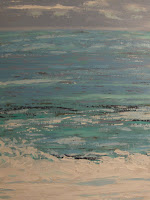
Today’s Image
In the Studio
Last week I finished an acrylic I worked on for a couple of days. It was not painted en plein air or from a reference photo as I don’t live anywhere near a desert nor have I taken a photo like this. The scene is totally from my mind’s eye, and is actually a compiled memory of both my residency and travels in the American Southwest. Although I titled it Deming Spring, it is not painted from anything real in Deming, New Mexico, USA; it is, however, a painting of an imagined spring morning there. My palette was Grumbacher's cobalt blue hue, cadmium yellow medium, cadmium red medium, burnt sienna, Payne's gray; Winsor & Newton's Galeria viridian, titanium white; Winsor & Newton's Finity olive green; and Liquitex's alizarin crimson. It’s Today’ Image.
My Opinion on Color Palettes
Before moving on to other art topics in upcoming Orbisplanis art blogs, I wanted to wrap up with a discussion of my opinion on color palettes.
When I renewed my interest in art in 2007, a color palette was not near the top of my interests—in fact, it wasn’t even on the list. As previously mentioned, not until I got interested in pastels (and later acrylics) did I even think about a color palette. With pastels I learned that most artists use a full array of pastel colors or at least as many as they can afford. In my reading and research on pastels, I don’t recall seeing the term palette used much, if at all, rather the discussion is more around how to mix and blend (optically and physically) as many pastel colors as you have at your disposal to achieve your goals. I’m guessing that the term palette was connected more with oil painting (using a wooden palette with a thumb hole to mix the paint) than with pastels. The Impressionists and other artists of their era used pastels in addition to oil paint. This was long before acrylics were invented, of course.
With acrylics I have gone from one extreme to the other I guess you could say. That is, I was initially drawn to acrylics not only for their speed and convenience but also because of all those colors! When you shop for acrylics you are bound to get hooked on all those colors hanging there on the racks. Depending on the brand, you have dozens of choices in what seems like every possible color. When I started painting with acrylics, I first bought the suggested palette of colors. A consensus of sources seem to agree on the ones I mentioned last blog, give or take one or two--cobalt blue, ultramarine blue, Paynes’ gray, viridian, burnt sienna, yellow ochre, cadmium lemon, cadmium yellow, orange, cadmium red, permanent rose, violet, and titanium white. I bought them all and more. It became like a game whenever I entered an art supply store—which color will I buy next? I would think of all the scenes I could paint with those colors, which I’m sure is what the marketing people at the acrylic paint companies intended. I haven’t counted but I must have at least 75 colors although some are duplicates.
However, as I kept researching art and artists I learned more about limited palettes. I learned that Claude Monet at one time used only cobalt blue, cadmium yellow medium, cadmium red, viridian, alizarin crimson, burnt sienna, and titanium white, and he seems to have had a pretty successful career :-). It’s highly likely, however, that there were only a few colors available then due to high cost and limited technology. I also read that the best way to learn about colors is to mix them yourself using a limited palette.
As I said, I went to the other extreme and for a while used only a limited palette. If it was good enough for Monet, then it’s good enough for me I reasoned. I did learn something about mixing colors, which is good. But maybe it’s my relative inexperience, or maybe it’s the way I mixed colors, but my paintings with a limited palette all seem to somehow look the same. Not the same motif, but they all have similar colors that make them look like they came from the same artist. Maybe that’s what the great artists did, but I found it disturbing that a desert landscape and a seascape looked oddly the same.
So today anyway I am of the opinion that I (and you) as the artist can do whatever I (you) please. You want to use a limited palette just like the Impressionists? Be my guest! You want to buy all the acrylic paints at your art supply store? Go ahead! In fact, you may need to. I discovered that you can only buy the color 'hot pink' (Winsor & Newtion Galeria Opera Rose). There is no combination of other (acrylic) colors you can mix to achieve it. So there!
I’m advocating experimentation, which I believe is the cornerstone to creativity. You may just become that next great artist who changes the art world for the next hundred years.
Cheers!





